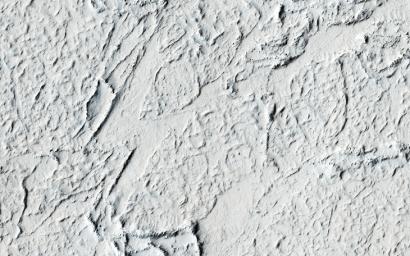
|
Flood Lavas and Mass Extinctions
- Click the image above for a larger view
- Full-Res JPEG (2880 x 1800) (1.1 MB)
- Full-Res TIFF (2880 x 1800) (15.6 MB)
Caption:

Map Projected Browse Image
Click on the image for larger version
This entire landscape is covered by lava flows. Almost all of vast Amazonis Planitia is covered by lava flows, an area comparable to that of the entire continental United States.
Amazonis Planitia is also one of the flattest places on Mars, because of the thick lava fill. Most of this lava was likely erupted in relatively short periods of time, perhaps thousands of years. Earth has also experienced relatively short-lived pulses with very high lava eruption rates, and these pulses precisely match the dates of four mass extinction events and a dozen or so smaller extinction peaks.
A mass extinction is when more than 75 percent of the species of life on the planet are completely killed off, never to return. On Earth, such high eruption rates release gases such as carbon dioxide that acidify the oceans, probably leading to the extinctions. The study of Mars and other worlds will help us to understand the processes causing high eruption rates.
Background Info:
The University of Arizona, Tucson, operates HiRISE, which was built by Ball Aerospace & Technologies Corp., Boulder, Colo. NASA's Jet Propulsion Laboratory, a division of the California Institute of Technology in Pasadena, manages the Mars Reconnaissance Orbiter Project for NASA's Science Mission Directorate, Washington.
Cataloging Keywords:
| Name | Value | Additional Values |
|---|---|---|
| Target | Mars | |
| System | ||
| Target Type | Planet | |
| Mission | Mars Reconnaissance Orbiter (MRO) | |
| Instrument Host | Mars Reconnaissance Orbiter | |
| Host Type | Orbiter | |
| Instrument | High Resolution Imaging Science Experiment (HiRISE) | |
| Detector | ||
| Extra Keywords | Color, Map | |
| Acquisition Date | ||
| Release Date | 2016-04-21 | |
| Date in Caption | ||
| Image Credit | NASA/JPL-Caltech/Univ. of Arizona | |
| Source | photojournal.jpl.nasa.gov/catalog/PIA20642 | |
| Identifier | PIA20642 | |
